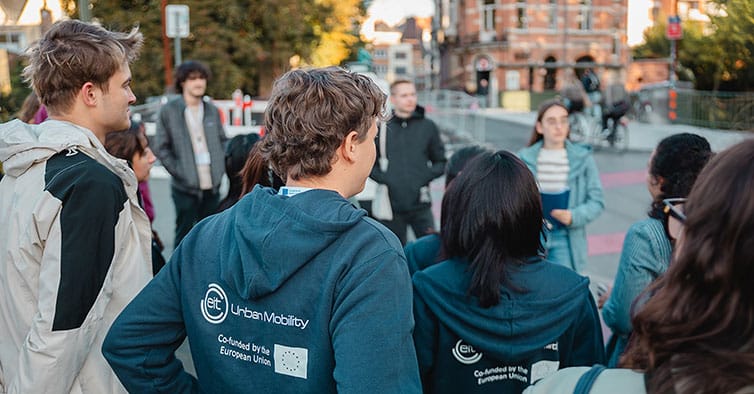
EIT Urban Mobility Master School

Cities are home to most of the world’s population – and this trend is only accelerating. Today, over half of the population lives in urban areas, and this figure is expected to rise to 68-70% by 2050. Yet, cities are also on the front line of global challenges: rising temperatures, increasingly frequent extreme weather events and rising pressure to decarbonise energy and transport systems. Urban mobility, therefore, sits at the centre of sustainable development and climate adaptation efforts.
As highlighted in the World Cities Report, building city resilience demands ambitious investments in sustainability, inclusive urban planning, stronger public health priorities and technological innovation that benefits all citizens.
The European Union has recognised this imperative. Through its Climate-Neutral and Smart Cities Mission, the EU aims to achieve at least 100 climate-neutral, innovation-driven cities by 2030, setting an example for others to follow by mid-century.
But there is no one-size-fits-all solution. Each city must find its own path, shaped by local contexts, technical know-how and community participation. Across Europe, cities are already demonstrating this diversity in action. Barcelona, Spain has reclaimed streets through its Superblocks and Urban Mobility Plan; Ghent, Belgium has restructured its traffic flows to prioritise cyclists and pedestrians; Stockholm, Sweden advances its Vision Zero policy to eliminate road deaths; and Lisbon, Portugal integrates bike lanes, shared mobility, and tram upgrades into a unified vision; to name only a few examples. Each of these approaches represents a different route toward a shared goal: cleaner, safer and more resilient urban mobility.
Meeting today’s urban challenges requires a new generation of mobility experts – planners, engineers and innovators capable of shaping the sustainable cities of tomorrow. But what can students entering an urban mobility programme in 2026 expect to learn to become effective professionals in this wide and evolving field?
In 2008, the European Institute of Innovation and Technology (EIT) was created to foster solutions to global challenges. A decade later, it launched EIT Urban Mobility, a Knowledge and Innovation Community (KIC) dedicated to accelerating the transition to sustainable urban transport. Within this framework, the EIT Urban Mobility Master School serves as the educational arm of the initiative. It offers three double-degree master’s programmes, delivered by eight leading European universities, combining technical excellence with a uniquely international perspective.
Perhaps unsurprisingly, mobility itself – and the exploration it inspires – stands out as the defining strength of studying urban mobility. Several graduates of the EIT Urban Mobility Master School shared their reflections on this transformative journey:
Mobility, quite literally, lies at the heart of EIT Urban Mobility master’s programmes. Students spend their first year at one partner university, then participate in a two-week Summer School held in two different cities (and countries), before completing their second year at another university in a new European setting. This unique structure enables students to experience a variety of urban systems, cultures and mobility challenges.
Edith, a Belgian student who graduated from the Master School in 2023, reflects: “The programme allowed me to experience various urban systems across Europe first-hand.” Her classmate Isabel, who comes from Germany, adds: “I particularly enjoyed the Summer School, which took place in Munich and Rotterdam. It was a fun way to explore new urban mobility initiatives and reappropriate the streets for ourselves.”
According to Samuel, a Slovakian student from the 2023 graduating class, “The strength of the programme lies in exposing students to diverse teaching methodologies across partner universities, fostering adaptability and cross-cultural learning.” Samuel studied one year at Aalto University in Finland and appreciated the programme’s emphasis on systems thinking: “It cultivates a holistic and systematic perspective, helping students avoid narrow viewpoints and instead develop solutions grounded in interconnected systems.”
On the other side of Europe, Carlos Arturo, from Colombia, who attended UPC Barcelona as his entry year, highlights the technical depth of the courses: “At UPC, the technical aspects of transport are solid, and very useful tools are shared that are relevant for many institutions involved in all forms of transport.”
Isabel summarises the programme in these terms: “The interdisciplinarity of this programme is ambitious, but at the same time it prepared me for different aspects of professional life in our field.”
The EIT Urban Mobility Master School attracts talented students from all over the world. This diversity has not gone unnoticed by the students themselves. Valentine, a French student from the second cohort, particularly appreciated the international exposure the programme offered: “It gives a very different experience than most master’s programmes and allows you to gain competencies beyond your main field. I also felt well prepared to work with very diverse people.”
That sentiment is echoed by Lukas, who is originally from Germany: “It was an exceptional opportunity to explore the international transportation landscape while building a valuable network of professionals in the field. It enriched my understanding of mobility through a deeper appreciation for the power of international collaboration.”
To conclude, Joaquín Andrés, from Colombia, captures beautifully why Europe remains the heartbeat of education in urban mobility: “What benefited me most was the psychological and behavioural component. When you understand that, in the end, you are not transporting numbers but beating hearts with stories, the way of planning or making decisions in transport returns to its true purpose – being a social service that benefits all social strata.”
And indeed, Europe offers a remarkable diversity of methodologies, practices and perspectives – all of which make it an unparalleled environment for learning, collaboration and innovation in urban mobility.
Learn more about EIT Urban Mobility Master SchoolThe latest articles from study abroad providers and StudyLink.com to hep you on your study abroad journey.
Read our key advice article to help you make the best decision for your education and start your International study adventure.

In this article we look at how to approach choosing where in the world you would like to study.

Read StudyLink's suggestions on your first steps when deciding where to study abroad, with helpful tips to make your decision easier.

Find out more about English language tests, your options and what is required as an overseas student.

StudyLink.com take a detailed look into the costs of studying abroad and all the aspects that you should budget for when embarking on your studies.

We answer 10 common questions about applying for a student visa to help make your visa application quick and easy.

Find out more about international student visas for studying abroad, as well as how, where and when to apply for yours.

Find out more about funding and scholarships for international students, and what financial assistance might be available to you.

How to choose a course that fits you? Check our top tips on choosing which course is best for you to help you make an informed decision.
Join the StudyLink email list and never miss a chance to turn your study abroad dreams into reality!
